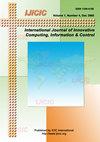Intrusion Alert Reduction Based on Unsupervised and Supervised Learning Algorithms
IF 1.1
Q4 COMPUTER SCIENCE, ARTIFICIAL INTELLIGENCE
International Journal of Innovative Computing Information and Control
Pub Date : 2021-10-31
DOI:10.11113/ijic.v11n2.331
引用次数: 1
Abstract
Security and protection of information is an ever-evolving process in the field of information security. One of the major tools of protection is the Intrusion Detection Systems (IDS). For so many years, IDS have been developed for use in computer networks, they have been widely used to detect a range of network attacks; but one of its major drawbacks is that attackers, with the evolution of time and technology make it harder for IDS systems to cope. A sub-branch of IDS-Intrusion Alert Analysis was introduced into the research system to combat these problems and help support IDS by analyzing the alert triggered by the IDS. Intrusion Alert analysis has served as a good support for IDS systems for many years but also has its own short comings which are the amount of the voluminous number of alerts produced by IDS systems. From years of research, it has been observed that majority of the alerts produced are undesirables such as duplicates, false alerts, etc., leading to huge amounts of alerts causing alert flooding. This research proposed the reduction alert by targeting these undesirable alerts through the integration of supervised and unsupervised algorithms and approach. The research first selects significant features by comparing two feature ranking techniques this targets duplicates, low priority and irrelevant alert. To achieve further reduction, the research proposed the integration of supervised and unsupervised algorithms to filter out false alerts. Based on this, an effective model was gotten which achieved 94.02% reduction rate of alerts. Making use of the dataset ISCX 2012, experiments were conducted and the model with the highest reduction rate was chosen. The model was evaluated against other experimental results and benchmarked against a related work, it also improved on the said related work.基于无监督和监督学习算法的入侵警报降低
在信息安全领域,信息安全与保护是一个不断发展的过程。入侵检测系统(IDS)是主要的防护工具之一。多年来,IDS被开发用于计算机网络,它们已被广泛用于检测一系列网络攻击;但它的主要缺点之一是攻击者,随着时间和技术的发展,使IDS系统更难应对。为了解决这些问题,研究系统引入了入侵防御的分支——入侵警报分析,并通过分析入侵防御触发的警报来支持入侵防御。入侵警报分析多年来一直为入侵检测系统提供良好的支持,但也有其自身的不足,即入侵检测系统产生的警报数量庞大。从多年的研究中可以观察到,产生的大多数警报都是不希望的,如重复警报,假警报等,导致大量警报,造成警报泛滥。本研究通过整合监督与无监督的算法和方法,针对这些不良警报提出了减少警报的方法。本研究首先通过对比两种特征排序技术筛选出重要特征,分别针对重复、低优先级和无关警报。为了进一步减少错误警报,研究提出了整合监督和无监督算法来过滤虚假警报。在此基础上,得到了一个有效的模型,该模型的告警减少率达到了94.02%。利用数据集ISCX 2012进行实验,选择了还原率最高的模型。该模型与其他实验结果进行了评估,并与相关工作进行了基准测试,并对该相关工作进行了改进。
本文章由计算机程序翻译,如有差异,请以英文原文为准。
求助全文
约1分钟内获得全文
求助全文
来源期刊
CiteScore
3.20
自引率
20.00%
发文量
0
审稿时长
4.3 months
期刊介绍:
The primary aim of the International Journal of Innovative Computing, Information and Control (IJICIC) is to publish high-quality papers of new developments and trends, novel techniques and approaches, innovative methodologies and technologies on the theory and applications of intelligent systems, information and control. The IJICIC is a peer-reviewed English language journal and is published bimonthly

 求助内容:
求助内容: 应助结果提醒方式:
应助结果提醒方式:


